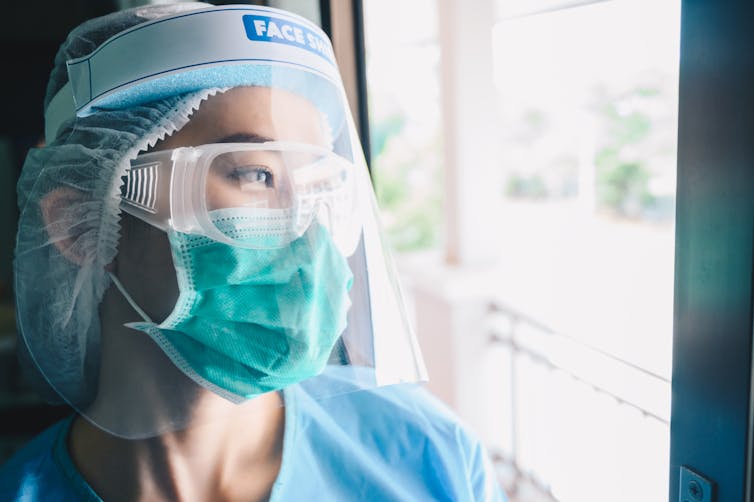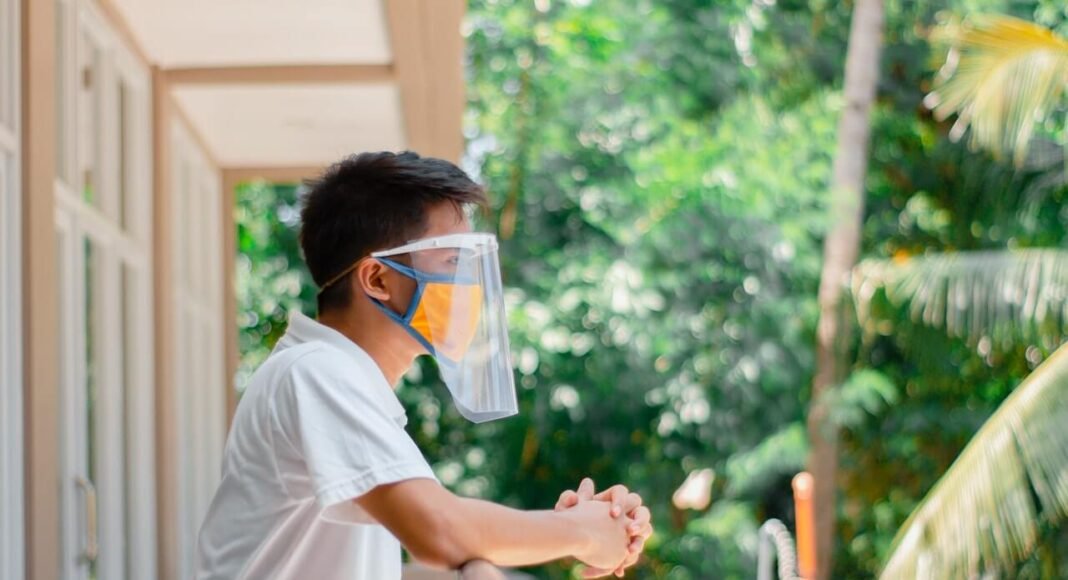By Philip Russo, Monash University and Brett Mitchell, University of Newcastle
For several weeks, Victorians have been required to wear a face covering when they leave home. And while we now have a clearer path out of lockdown, it’s likely masks will be around for a while.
Meanwhile, people in other states with outbreaks have been encouraged to wear masks, and some people are simply choosing to wear one as a precaution.
But some people in the community, instead of opting for a traditional mask, are instead wearing a face shield.
This might offer some degree of protection — but it’s probably not as good as a mask in preventing the spread of COVID-19.
What is a face shield?
A face shield is a film made from plastic or other transparent material designed to be worn like a visor. It’s attached using a band that goes around the top of your head.
Think of a visor a welder wears to protect themselves from sparks and injury. Health-care workers use face shields to block bodily fluids from coming into contact with their face, and potentially causing infection.
It’s likely many people are choosing face shields during COVID-19 because they’re experiencing discomfort wearing a mask — whether glasses fogging up, irritation around the ears, or just that extra layer.
The term “face covering”, as per the Victorian government’s guidelines, is notably vague. It can include a face mask, a face shield, or a scarf or bandana.
The department of health does however recommend a mask over a face shield.
Read more: Which face mask should I wear?
How effective are face shields?
A letter, published recently in the journal Physics of Fluids, reported on a laboratory experiment where scientists put face shields to the test.
They simulated coughing by connecting the head of a mannequin to a fog machine, and then using a pump to expel the vapour through the mannequin’s mouth.
They found that while face shields stopped the droplets being propelled forwards, aerosolised droplets — those much smaller in size — lingered at the bottom of the shield and floated around at the sides. They eventually spread approximately 90 centimetres from the mannequins.

This is an interesting laboratory experiment, but not conclusive evidence face shields offer less protection than masks in the community.
A lack of research on the effectiveness of face shields means it’s not possible to make any strong recommendations for or against their use.
Where does this leave us?
There’s a lot we still don’t know about this virus and how it spreads.
At present, we believe the virus is spread generally through close contact with an infectious person, contact with the droplets emitted when they sneeze or cough, or contact with surfaces these droplets have contaminated.
To establish an infection the virus enters your body through portals of entry: the mouth, nose and eyes.
Wearing a mask is intended to protect others if you have the infection, by blocking the droplets coming out of your mouth and nose. We call this source control. To a degree — though we have less evidence on this front — it’s also likely to protect you, the wearer, by providing a physical barrier to your portals of entry.
A face shield may offer an advantage in that it provides a physical barrier over all your portals of entry — your eyes as well as your mouth and nose. Shields may also reduce the frequency of the wearer touching their face, and have the added benefit of allowing the person’s face to be seen (if they’re not wearing a mask as well).
However, as they’re not tight fitting, aerosols may still enter and exit around the outside of a face shield, where it’s not fitted in the same way a mask is. And we’re continuing to accumulate evidence about the possible role of aerosolised transmission in the spread of COVID-19, which the World Health Organisation is closely monitoring.
Correct use is important too
Whatever face covering you choose, you must use it properly, and it must fit correctly.
Having masks slung under the chin, hanging off one ear, or your nose poking out over the top of the mask will make them markedly less effective. And of course frequently touching and re-adjusting the mask means we’re possibly contaminating our hands too.
If you don’t intend to wear a mask properly or you’re unable to, then a face shield is a better option. You can also wear mask and a face shield together, should you wish to.
Like masks, there are a variety of face shields available, varying in quality and size. The department of health advise if you wear a face shield it should cover “the wearer’s forehead to below the chin area and wrapping around the sides of the wearer’s face”.
You should not share a face shield. If they’re labelled disposable, don’t reuse them. And if they are reusable you need to clean them regularly following the manufacturer’s instructions.
The upshot
Masks worn correctly are the best option. When wearing a mask is not possible, then a face shield is better than nothing. Neither will work well if not used properly, and importantly, they don’t replace physical distancing and hand hygiene.
Read more: How to talk to someone who doesn’t wear a mask, and actually change their mind
Philip Russo, Associate Professor, Director Cabrini Monash University Department of Nursing Research, Monash University and Brett Mitchell, Professor of Nursing, University of Newcastle
This article is republished from The Conversation under a Creative Commons license. Read the original article.


